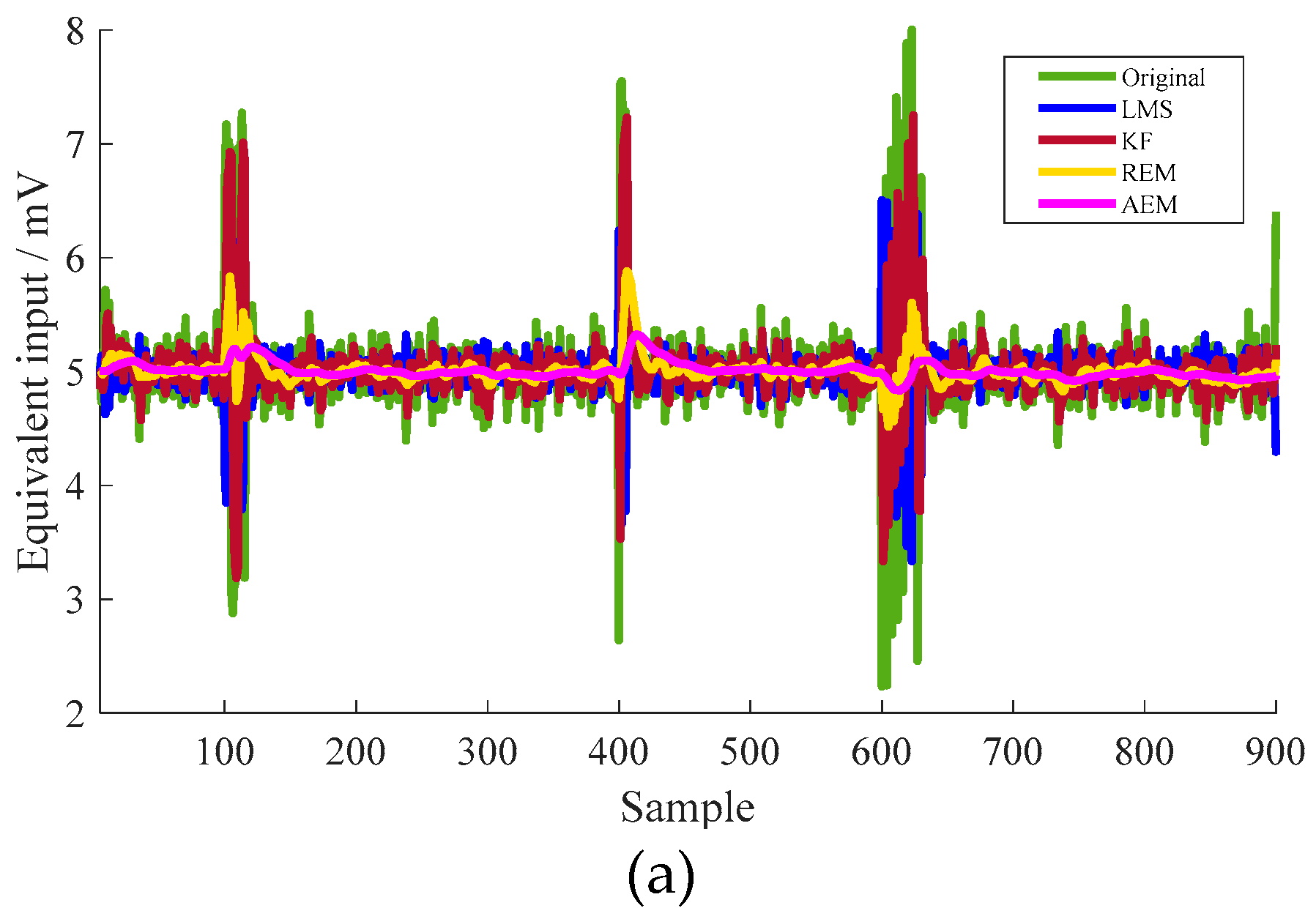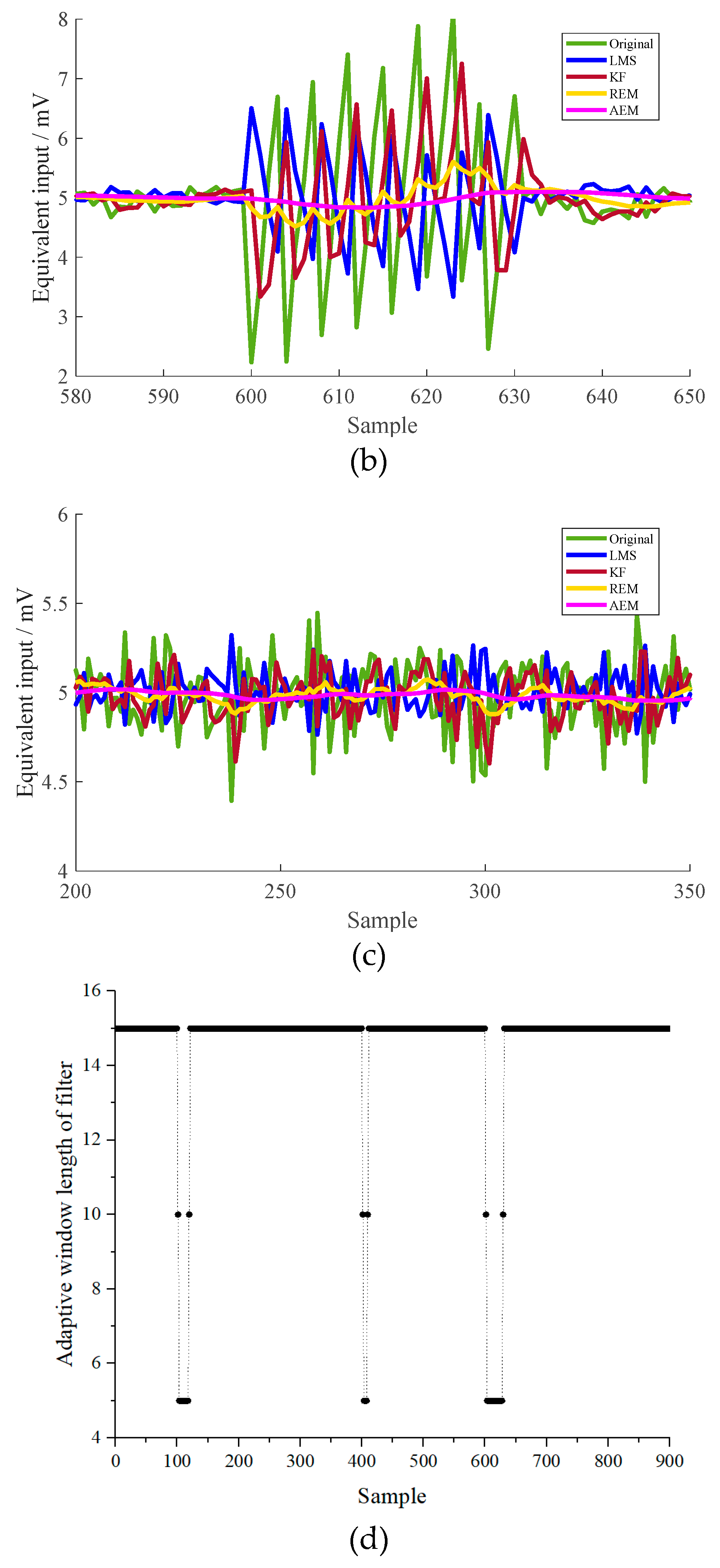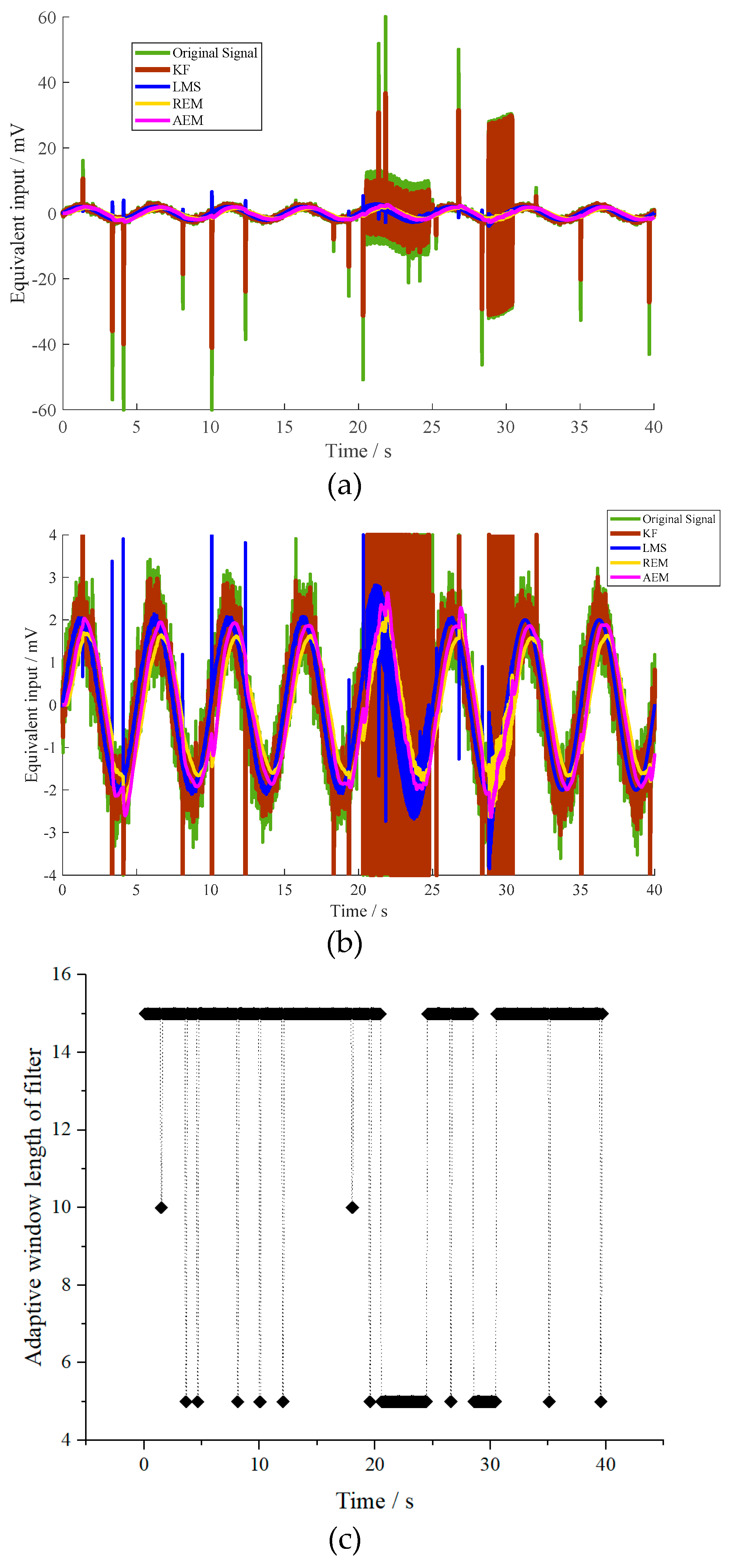A Measurement-Data-Driven Control Approach towards Variance Reduction of Micromachined Resonant Accelerometer under Multi Unknown Disturbances
Abstract
1. Introduction
2. Modelling of the Accelerometer Output Under Unknown Input
3. Joint Estimation and Identification Strategy Based on the Data-Driven Iterative Optimization
3.1. Likelihood Function of the Accelerometer Sensor Measurement
3.2. Joint Estimation and Identification based on Iterative Optimization
- E step:where is the number of iterations, Q(r) represents
- M step:
3.3. Adaptive Selection on Window Length of Filter
4. Experimental Test and Comparison
4.1. Static Performance Test
4.2. Dynamic Performance Test
5. Conclusions
Author Contributions
Funding
Conflicts of Interest
References
- Elena, G.; Robert, N. Smart MEMS and Sensor Systems; World Scientific Publishing: Singapore, 2006. [Google Scholar]
- Bhushan, B. Springer Handbook of Nanotechnology; Springer: New York City, NY, USA, 2017. [Google Scholar]
- Nihtianov, S.; Luque, A. Smart Sensors and MEMS: Intelligent Sensing Devices and Microsystems for Industrial Applications; Woodhead Publishing: Cambridge, UK, 2018. [Google Scholar]
- Zhao, C.; Pandit, M.; Sun, B.; Sobreviela, G.; Zou, X.; Seshia, A. A closed-loop readout configuration for mode-localized resonant MEMS sensors. J. Microelectromech. Syst. 2017, 26, 501–503. [Google Scholar] [CrossRef]
- Yang, J.; Zhong, J.; Chang, H. A closed-loop mode-localized accelerometer. J. Microelectromech. Syst. 2018, 27, 210–217. [Google Scholar] [CrossRef]
- French, P.; Krijnen, G.; Roozeboom, F. Precision in harsh environments. Microsyst. Nanoeng. 2016, 2, 16048. [Google Scholar] [CrossRef]
- Hajjaj, A.Z.; Jaber, N.; Hafiz, M.A.A.; IIyas, S.; Younis, M.I. Multiple internal reonances in MEMS arch resonators. Phys. Lett. A 2018, 382, 3393–3398. [Google Scholar] [CrossRef]
- Zhao, C.; Montaseri, M.H.; Wood, G.S.; Pu, S.H.; Seshia, A.A.; Kraft, M. A review on coupled MEMS resonators for sensing applications utilizing mode localization. Sens. Actuators A 2016, 249, 93–111. [Google Scholar] [CrossRef]
- Senkal, D.; Ahamed, M.J.; Trusov, A.A.; Shkel, A.M. Achieving sub-Hz frequency symmetry in micro-glassblown wineglass resonators. J. Microelectromech. Syst. 2014, 23, 30–38. [Google Scholar] [CrossRef]
- Bernstein, J.J.; Bancu, M.G.; Bauer, J.M.; Cook, E.H.; Kumar, P.; Newton, E.; Nyinjee, T.; Perlin, G.E.; Ricker, J.A.; Teynor, W.A. High Q diamond hemispherical resonators: Fabrication and energy loss mechanisms. J. Micromech. Microeng. 2015, 25, 085006. [Google Scholar] [CrossRef]
- Saito, D.; Yang, C.; Heidari, A.; Najar, H.; Lin, L.; Horsley, D.A. Microcrystalline diamond cylindrical resonators with quality-factor up to 0.5 million. Appl. Phys. Lett. 2016, 108, 051904. [Google Scholar] [CrossRef]
- Wang, X.; Zhao, J.; Zhao, Y.; Xia, G.M.; Qiu, A.P.; Su, Y.; Xu, Y.P. A 0.4μg Bias Instability and 1.2μg/√Hz Noise Floor MEMS Silicon Oscillating Accelerometer with CMOS Readout Circuit. IEEE J. Solid-State Circuit 2017, 52, 472–482. [Google Scholar] [CrossRef]
- Shen, Q.; Wang, X.P.; Wu, Y.X.; Xie, J.B. Oscillation suppression in the sense mode of a high-q mems gyroscope using a simplified closed-loop control method. Sensors 2018, 18, 2443. [Google Scholar] [CrossRef]
- Schröder, S.; Niklaus, F.; Nafari, A.; Westby, E.R.; Fischer, A.C.; Stemme, G.; Haasl, S. Stress-minimized packaging of inertial sensors by double-sided bond wire attachment. J. Microelectromech. Syst. 2015, 24, 781–789. [Google Scholar] [CrossRef]
- Wang, X.; Xiao, D.; Hou, Z.; Li, Q.; Chen, Z.; Wu, X. Temperature robustness design for double-clamped MEMS sensors based on two orthogonal stress-immunity structure. In Proceedings of the 2015 IEEE Sensors, Busan, South Korea, 1–4 November 2015; pp. 1–4. [Google Scholar]
- Königer, T. New die attach adhesives enable low-stress MEMS packaging. In Proceedings of the 36th International Electronics Manufacturing Technology Conference, Johor Bahru, Malaysia, 11–13 November 2014; pp. 1–5. [Google Scholar]
- Friedland, B. Treatment of bias in recursive filtering. IEEE Trans. Autom. Control 1969, 14, 359–367. [Google Scholar] [CrossRef]
- Nikolic, J.; Furgale, P.; Melzer, A.; Siegwart, R. Maximum likelihood identification of inertial sensor noise model parameters. IEEE Sens. J. 2016, 16, 163–176. [Google Scholar] [CrossRef]
- Zhang, S.-Q.; Schmidt, R.; Müller, P.C.; Qin, X.-S. Disturbance rejection control for vibration suppression of smart beams and plates under a high frequency excitation. J. Sound Vib. 2015, 353, 19–37. [Google Scholar] [CrossRef]
- Lin, X.; Bar-Shalom, Y.; Kirubarajan, T. Exact multisensor dynamic bias estimation with local tracks. IEEE Trans. Aerosp. Electron. Syst. 2004, 40, 576–590. [Google Scholar]
- Okello, N.N.; Challa, S. Joint sensor registration and track-to-track fusion for distributed trackers. IEEE Trans. Aerosp. Electron. Syst. 2004, 40, 808–823. [Google Scholar] [CrossRef]
- Zhou, J.; Liang, Y.; Shen, Q.; Feng, X.; Pan, Q. A Novel Energy-Efficient Multi-Sensor Fusion Wake-Up Control Strategy Based on a Biomimetic Infectious-Immune Mechanism for Target Tracking. Sensors 2018, 18, 1255. [Google Scholar] [CrossRef] [PubMed]
- Kounades-Bastian, D.; Girin, L.; Alameda-Pineda, X.; Gannot, S.; Horaud, R. A variational EM algorithm for the separation of time-varying convolutive audio mixtures. IEEE Trans. Audio Speech Lang. Process. 2016, 24, 1408–1423. [Google Scholar] [CrossRef]
- Trinh, H.; Ha, Q.P. State and input simultaneous estimation for a class of time-delay systems with uncertainties. IEEE Trans. Circuits Syst. II 2007, 54, 527–531. [Google Scholar] [CrossRef]
- Li, Q.; Shen, B.; Liu, Y.; Alsaadi, F.E. Event-triggered H∞ state estimation for discrete-time stochastic genetic regulatory networks with Markovian jumping parameters and time-varying delays. Neurocomputing 2016, 174, 912–920. [Google Scholar] [CrossRef]
- Qiu, J.; Feng, G.; Yang, J. Robust mixed H2/H∞ filtering design for discrete-time switched polytopic linear systems. IET Control Theory Appl. 2008, 2, 420–430. [Google Scholar] [CrossRef]
- Li, X.R.; Jilkov, V.P. Survey of maneuvering target tracking. Part V. Multiple-model methods. IEEE Trans. Aerosp. Electron. Syst. 2005, 41, 1255–1321. [Google Scholar]
- Qin, Y.; Liang, Y.; Yang, Y.; Pan, Q.; Yang, F. Minimum upper-bound filter of Markovian jump linear systems with generalized unknown disturbances. Automatica 2016, 73, 56–63. [Google Scholar] [CrossRef]
- Yin, S.; Ding, S.X.; Xie, X.; Luo, H.J.I.T.o.I.E. A review on basic data-driven approaches for industrial process monitoring. IEEE Trans. Ind. Electron. 2014, 61, 6418–6428. [Google Scholar] [CrossRef]
- Liu, S.; Wang, Y.; Tian, F. Prognosis of underground cable via online data-driven method with field data. IEEE Trans. Ind. Electron. 2015, 62, 7786–7794. [Google Scholar] [CrossRef]
- Wang, Y.; Peng, Y.; Zi, Y.; Jin, X.; Tsui, K.-L. A two-stage data-driven-based prognostic approach for bearing degradation problem. IEEE Trans. Ind. Electron. 2016, 12, 924–932. [Google Scholar] [CrossRef]
- Imani, M.; Braga-Neto, U.M. Maximum-likelihood adaptive filter for partially observed boolean dynamical systems. IEEE Trans. Signal Process. 2017, 65, 359–371. [Google Scholar] [CrossRef]
- Kalyaanamoorthy, S.; Minh, B.Q.; Wong, T.K.; von Haeseler, A.; Jermiin, L.S. ModelFinder: Fast model selection for accurate phylogenetic estimates. Nat. Methods 2017, 14, 587. [Google Scholar] [CrossRef]
- Shen, Q.; Li, H.; Hao, Y.; Yuan, W.; Chang, H. Bias contribution modeling for a symmetrical micromachined Coriolis vibratory gyroscope. IEEE Sens. J. 2016, 16, 723–733. [Google Scholar] [CrossRef]
- Shen, Q.; Chang, H.; Wu, Y.; Xie, J. Turn-on bias behavior prediction for micromachined Coriolis vibratory gyroscopes. Measurement 2019, 131, 380–393. [Google Scholar] [CrossRef]
- Cao, H.; Zhang, Y.; Han, Z.; Shao, X.; Gao, J.; Huang, K.; Shi, Y.; Tang, J.; Shen, C.; Liu, J. Pole-Zero-Temperature Compensation Circuit Design and Experiment for Dual-mass MEMS Gyroscope Bandwidth Expansion. IEEE-ASME Trans. Mechatron. 2019, 24, 677–688. [Google Scholar] [CrossRef]
- Li, E.; Shen, Q.; Hao, Y.; Xun, W.; Chang, H. A novel virtual accelerometer array using one single device based on time intervals measurement. In Proceedings of the 2018 IEEE Sensors, New Delhi, India, 28–31 October 2018. [Google Scholar] [CrossRef]






| Step | Description |
| 1). Preparation | Derivative likelihood functions |
| 2). Start | Set window length v of the filter |
| 3). Obtain Data | Obtain measurement sequence , as shown in Figure 1. |
| Iterate the joint estimation and identification algorithm: for r = 1, 2, … | |
| 4). E-Step | Use KF to estimate , then calculate the expectation value of the log likelihood function |
| 5). M-Step | Identify the parameters to ensure the above expectation value to reach the maximum value |
| 6). Termination | Calculate in Equation (20), If or , then terminate the current number of iterations as . Else, update as by replacing with the above , and go to step 4. |
| 7). Result | Obtain optimal |
| Group | Shock Displacement (mm) | Number of Shock | Cycles Time (s) |
|---|---|---|---|
| 1 | 0.18 | 2 | 1 |
| 2 | 0.2 | 1 | - |
| 3 | 0.22 | 8 | 0.3 |
| Methods | Variance (mV) | Reduction of Proposed Method |
|---|---|---|
| KF | 0.212 | 1.9% |
| LMS | 0.149 | 2.8% |
| REM | 0.015 | 27.3% |
| AEM | 0.004 | - |
| Group | Amplitude (mm) | Frequency (Hz) | Duration (s) | Load Form |
|---|---|---|---|---|
| 1 | 3 | - | 1.2 × 10−5 | Pulse signal |
| 2 | 1.7 | 77 | 4.5 | Squared wave |
| 3 | 2.2 | 18 | 1.6 | Squared wave |
| Methods | Variance (mV) | Reduction of Proposed Method |
|---|---|---|
| KF | 35.5 | 4.1% |
| LMS | 2.07 | 70.1% |
| REM | 2.0 | 72.5% |
| AEM | 1.45 | - |
© 2019 by the authors. Licensee MDPI, Basel, Switzerland. This article is an open access article distributed under the terms and conditions of the Creative Commons Attribution (CC BY) license (http://creativecommons.org/licenses/by/4.0/).
Share and Cite
Shen, Q.; Yang, D.; Zhou, J.; Wu, Y.; Zhang, Y.; Yuan, W. A Measurement-Data-Driven Control Approach towards Variance Reduction of Micromachined Resonant Accelerometer under Multi Unknown Disturbances. Micromachines 2019, 10, 294. https://doi.org/10.3390/mi10050294
Shen Q, Yang D, Zhou J, Wu Y, Zhang Y, Yuan W. A Measurement-Data-Driven Control Approach towards Variance Reduction of Micromachined Resonant Accelerometer under Multi Unknown Disturbances. Micromachines. 2019; 10(5):294. https://doi.org/10.3390/mi10050294
Chicago/Turabian StyleShen, Qiang, Dengfeng Yang, Jie Zhou, Yixuan Wu, Yinan Zhang, and Weizheng Yuan. 2019. "A Measurement-Data-Driven Control Approach towards Variance Reduction of Micromachined Resonant Accelerometer under Multi Unknown Disturbances" Micromachines 10, no. 5: 294. https://doi.org/10.3390/mi10050294
APA StyleShen, Q., Yang, D., Zhou, J., Wu, Y., Zhang, Y., & Yuan, W. (2019). A Measurement-Data-Driven Control Approach towards Variance Reduction of Micromachined Resonant Accelerometer under Multi Unknown Disturbances. Micromachines, 10(5), 294. https://doi.org/10.3390/mi10050294




